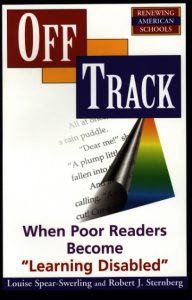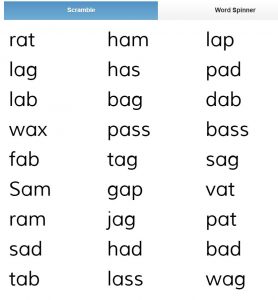Don’t assume your OLDER student can learn on the same path as a younger one.
 The key idea in the excellent book “Off-Track – When Poor Readers Become “Learning Disabled” is that readers who leave the standard path to reading KEEP LEARNING. The skills they learn might be compensatory or substituting, allowing the reader to participate in school and work. Or they might be self-defeating and lead to a dead end. The point is that the struggling reader continues to evolve, and a tutor cannot simply pick up at the point where that student exited the standard path.
The key idea in the excellent book “Off-Track – When Poor Readers Become “Learning Disabled” is that readers who leave the standard path to reading KEEP LEARNING. The skills they learn might be compensatory or substituting, allowing the reader to participate in school and work. Or they might be self-defeating and lead to a dead end. The point is that the struggling reader continues to evolve, and a tutor cannot simply pick up at the point where that student exited the standard path.
I had a harsh reminder of this today. I’ve been tutoring an adult over the internet; Her name is Leila, she’s 41, and reads at a grade-1 level. She has an almost-adult daughter, and the two of them live in her mom’s basement. She is whip-smart, focused, and perceptive, but her life has been hard without reading. She writes with speech-to-text, and ‘reads’ with text-to-speech.
The first time we ‘met’, I asked her to read for me. She could sound out fairly complex words that she had never seen written down. She often messed up the small function words (‘a’ instead of ‘the’), but could sound out one-syllable words and often got affixed words right (‘communicate’). She could blend, and knew her phonics (‘ee’ usually makes the /ee/ sound), so I assumed she didn’t need our BLENDING program.
So we launched directly into reading. Every morning for two weeks, we struggled through a chapter of Goosebumps, a grade-3 chapterbook. It takes about 30 minutes for her to read a chapter, typically about 250 words. Then we do a ‘repeated reading’ exercise to build fluency and sight-recognition word inventory.
She is getting more words right, especially the function words. But she doesn’t have automaticity; she laboriously struggles with every word, trying to sound them out or guess them with from context and first-and-last-letters. Reading is hard work for her, full of errors, slow, and exhausting. I make sure she stays ‘in the story’ by re-reading passages, but she wouldn’t understand a Goosebumps on her own.
I assumed that she would become a smoother, faster reader by reading with me every day, and sure enough she is getting smoother and faster. But I realized she isn’t becoming a better reader, she is becoming a better GUESSER. If we had kept going, she would become a disabled reader, stuck forever at grade-3 level.
 Today I asked her to try a simple /ah/ word-list (like the one on the right). Oops. She gets every word right, every time. But sooooo slowly. After 3 pages of these words, she is still reading about one word every five seconds, and it’s so hard that I’m afraid her head will explode.
Today I asked her to try a simple /ah/ word-list (like the one on the right). Oops. She gets every word right, every time. But sooooo slowly. After 3 pages of these words, she is still reading about one word every five seconds, and it’s so hard that I’m afraid her head will explode.
There’s nothing wrong with her. ‘Learning’ is represented in our brain by creating new connections, and she simply hasn’t built the neuron wiring to process these simple words. There’s no shortcut, it requires repetition and time.
So we are going to start working through BLENDING, 20 minutes every day. We must both UNLEARN the guessing skills that are keeping her back and give her replacement skills. (See: Design of the BLENDING Program)
In 2-3 days she will start to ‘get’ the /ah/ words and become smoother with them. Then we’ll move to /ih/ words, and then to contrasting /ah/ and /ih/, and then /aw/ words, and so on. In 3 weeks she will be kicking back 4- and 5- letter short-vowel words. We’ll ease up on the reading a bit during that time.
If anyone should have recognized the need to go back and learn blending, you think it would be me. But I assumed… And she was drifting towards exactly the trap that catches students using 3-cue programs like ‘Reading Recovery’.
No great harm, our two weeks until now were not completely wasted. We built good habits, and we will get back on track. But don’t make the same mistake with your precious student.



Leave a Reply